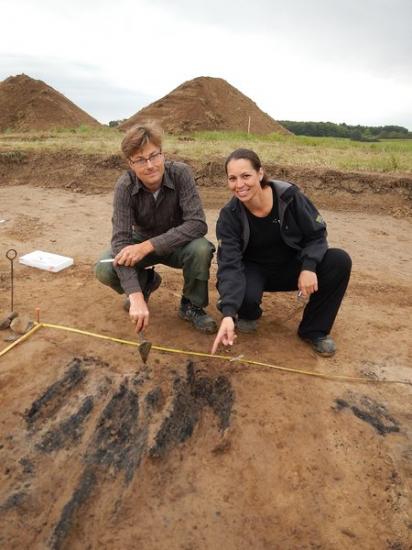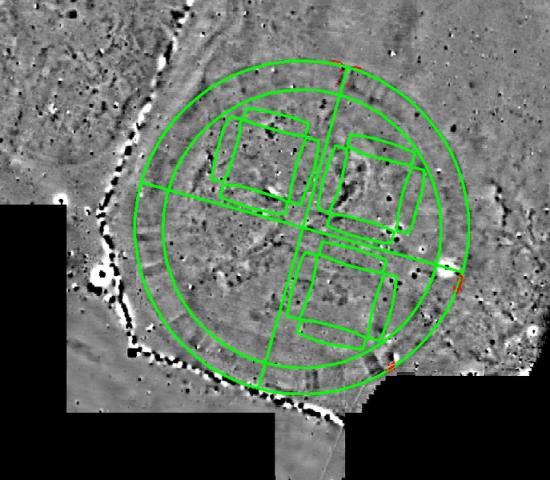Aarhus University
Source - http://cas.au.dk/en/currently/singlenews/artikel/-e5f0f3453f/
In collaboration with the diocese of Vallø, archaeologists from the Danish Castle Centre and Aarhus University have discovered a previously unknown Viking fortress in a field west of Køge, Denmark. The discovery could be an important piece in Denmark’s historical jigsaw puzzle.

Søren Sindbæk and Nanna Holm at the excavation site
Archaeologists have discovered traces of a circular Viking fortress and embankments in a field in the diocese of Vallø, west of Køge. The circular fortress is similar to the famous “Trelleborg” fortresses built by King Harald Bluetooth around the year 980 AD.
“This is the first time for more than 60 years that a new Viking ringed fortress has been discovered in Denmark,” explains Nanna Holm, an archaeologist and curator at the Danish Castle Centre. Her colleague on the excavation Søren Sindbæk, who is a professor of medieval archaeology at Aarhus University, adds:
“The discovery of the new Viking fortress is a unique opportunity to learn more about the battles and conflicts of the Vikings, and gives us a new chance to study the most famous of our Viking monuments.”
Found by laser

Ground plan of the Fyrkat Viking fortress placed on top of the Vallø ringed fortress. The red lines show the outline of the Vallø excavation. © Danish Castle Centre
It was new, precise laser measurements of the landscape that put Nanna Holm from the Danish Castle Centre in Vordingborg on the track. These measurements showed that an almost imperceptible mound in the field had a clear circular outline, so Holm and Sindbæk decided to call in an expert in archaeological geophysics from the University of York in the UK.
“Measuring small variations in the magnetic field of the soil enables you to identify old pits or embankments without destroying them. The technique gave us a surprisingly detailed image of the fortress in no more than a few days. So we knew exactly where to dig the excavation trenches with a view to learning as much as possible about the fortress,” explains Sindbæk.
Burnt timber and radiocarbon dating
Nanna Holm underlines that the fortress was a genuine military facility, and probably the scene of fighting as well. She’s in no doubt that it dates back to the Viking Age.
“Fortresses built like this one were only built in the Viking Age, and the burnt timber in the gates enables us to fix the date using radiocarbon dating and dendrochronology. We’ve sent off samples for analysis, and the result should be available in a few weeks’ time. The date will be vital. If we can establish exactly when the fortress was built, it will help us to understand the historical events with which it was connected.”
Viking ringed fortresses may be the most famous historical monuments in Denmark. They attract tourists from all over the world, and have led to revisions of Danish history on a number of occasions.
Unresolved questions
The discovery could be an important piece of the jigsaw puzzle in understanding the history of Denmark.
“We can’t wait to find out whether the fortress dates back to the time of Harald Bluetooth, or whether it was built by a previous king. A military fortification from the Viking Age may shed more light on the links between Zealand, ancient Denmark and the Jelling dynasty – as well as teaching us more about the period during which Denmark became Denmark,” says Holm.
Only a few small parts of the fortress have been excavated so far. The list of unresolved questions is still long.
“The excavation has already confirmed far more than we dared to hope, but we don’t know the whole story yet. The next question is whether any big buildings were built inside the fortress, as they were in the Trelleborg fortresses. You also have to ask yourself if there are any more hidden ringed fortresses out there,” concludes Sindbæk.